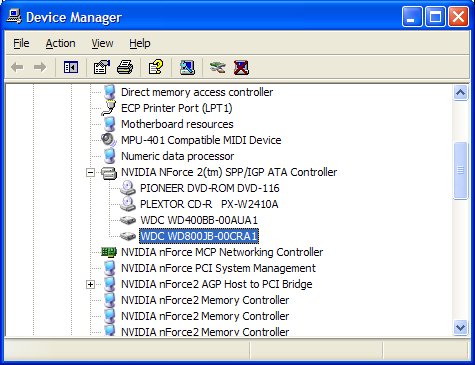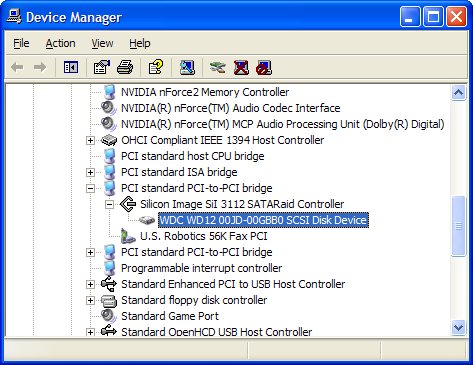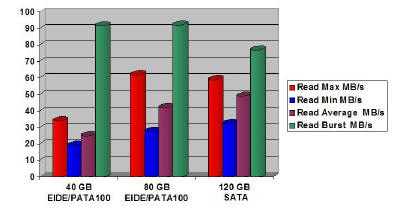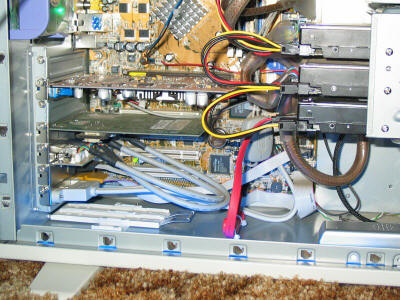
With birthdays come presents, and among other things this year I was given the go ahead to pick out and purchase another hard drive for my desktop machine. While this is probably not a great flash of insight, hard drives are like closets -- the more space you have the more "junque" you can store. So if for nothing else but backup, I wanted to keep my current hard drives.
I've never been blessed in having 2 hard drives of the same size. Seems I can only upgrade one at a time, and lately it's been the 40 GB stair step. So before I looked to upgrade I had one 40 GB PATA 100 drive with 2 MB cache, and one 80 GB 7200 RPM PATA 100 drive with 8 MB cache (the "p" in PATA is for parallel ATA drive as opposed SATA or Serial ATA) . They are both Western Digital. I've been happy with my WD drives so I was looking for another WD drive.
Before we start hard drive wars here, pretty much anyone's hard drives are good these days. There are no current "Deathstar" award contenders. I suggest that others choose the drive manufacturer or features that they prefer. I'm not here to endorse Western Digital over the rest of the pack. Their products just happen to work well for me and they have gained my personal loyalty.

Windows XP Device Manager showing PATA Hard Drive Connections
With all of that said, what is my new hard drive? I got a Western Digital 120 GB 7200 RPM SATA (sorta) drive with 8 MB cache. And why the sorta? Well, except for some Seagate Barracudas, none of the other SATA drives currently have native SATA support. The cold hard truth is that all the rest of the SATA drives out there are your basic EIDE drive with what amounts to a SATA adapter built in, a PATA-to-SATA bridge chip. And so it is with my new hard drive.
I need to mention that I could have gone the SATA route by using an EIDE drive with an external SATA adapter. The advantage to the built in bridge over an SATA adapter is that the drive is the same size as an EIDE drive without a SATA adapter sticking off the back end of the drive.
In spite of the manufacturer's true but hyped 150 MB/s claim, today's hard drive performance is based on the quality and design of the drive, not on it's being SATA or PATA. SATA (1.0) does support transfers of up to 150 MB/s. However, current drives and mainboards don't support those speeds. So don't expect a performance boost from your new SATA drive unless it is something like WD's Raptor. The Raptors get their performance boost (on par with SCSI drives) from being high performance drives, not from their inclusion of a PATA-to-SATA bridge.

Windows XP Device Manager showing SATA Hard Drive Connection.
While my mainboard has onboard SATA support, it is implemented as a SATARaid controller and is not native to the chipset. Note that the SATARaid controller is on the PCI to PCI bridge. Obviously, with only one hard drive hung off of it, I'm not currently running a RAID array.
Once I had the hard drive up and running I wanted to see exactly how it was performing. The following three screen shots show the comparative read performance of the three hard drives in my computer starting with the smallest/oldest and ending with the largest/newest. While the 2 PATA drives out perform the SATA drive on Read Burst, the SATA drive shines on the Sequential Speed. These tests were run on the same computer within seconds of each other.

Comparison graph for all 3 hard drives
What would be more interesting would be to compare the 120 GB EIDE/PATA version of the same drive (WD1200JB) with the SATA drive (WD1200JD) in the same machine. Sadly we don't have "one of" at this time in order to run the test. It is difficult without a more direct comparison to explain the low Read Burst. Likewise the higher Read Average is not necessarily a function of the SATA interface. What it does prove is that dropping a SATA drive into my year old system did not give me a performance boost. I feel that in real life terms I neither gained nor lost hard drive performance overall.
So that brings us to the question of why even bother with SATA at this point in time? I have several reasons. First, and certainly always an important factor is cost. The SATA version of this drive cost me a mere $12 more than the comparable EIDE/PATA drive. That's not enough to worry about and is a important motivation for adopting new technology. Second, I didn't want to add a PCI ATA 100 adapter to my computer, and I was out of "plugs". In other words, I had no free IDE connections since I already had 2 hard drives on the Primary and a DVD and CDRW on the Secondary IDE channels. Third, while I find the term "future proof" nothing more than wishful thinking, buying a drive that uses the newer interface may make it more easily usable with my next mainboard. And last, but certainly not least, the new SATA cables are nothing short of nifty. The ends of the cables have sturdy and fool-proof plugs that you can only attach one way. There is no worry about master and slave connectors or jumpers. There is just one cable per SATA channel, with one end plugged into the mainboard or SATA adapter card and the other end plugged into the hard drive. If that were not enough both ends of the cable are the same so it doesn't matter which end is used, it will be right.
This particular SATA drive has a legacy power connector as well as the SATA power connector. I'm currently using the legacy connector because it makes wire routing easier, however SATA power adapters are available and cost as little as $3 or $4.

The little red SATA cable going from the mainboard to the
bottom hard drive can be easily seen in the picture. Also viewable is the Silicon Image 3112
SATARaid controller on the mainboard just to the left of the SATA cable. Notice
the rounded IDE cable connecting the 2 upper drives.
I've given a very personal look at SATA here, but there is a wealth of other information available on the subject. The following links are things I read before, after, and during the decision to buy my first SATA drive.
SerialATA.Org - Your Source for Serial ATA Information
Serial ATA Explained – What’s the big deal?
Serial ATA - It's Time to Get in Line
Explosive Labs - Serial ATA - The Dawn of a New Era
Barracuda Serial ATA V - ST3120023AS -- a drive with native SATA support
Western Digital Caviar WD2500JD -- an article about a drive similar to mine with some insights on the use of PATA-to-SATA bridge chips
COMAX TECHNOLOGY INC. -- one of the developers of SATA cables and connectors
Serial ATA Adaptors and Cables -- yes, you can get the light up cables, too
IDE to Serial ATA Converter from Addonics -- if you just gotta have SATA
Ars Technica Plextor sports a 12x Serial ATA DVD+R writer -- did I forget to mention? More SATA devices are on the way!
© 2004 Gail Allinson
© 2002 - 2004 by On Computers and the Videotex Services
Coalition.![]()